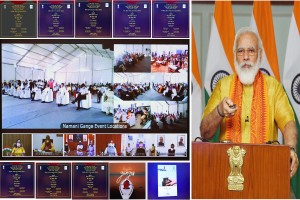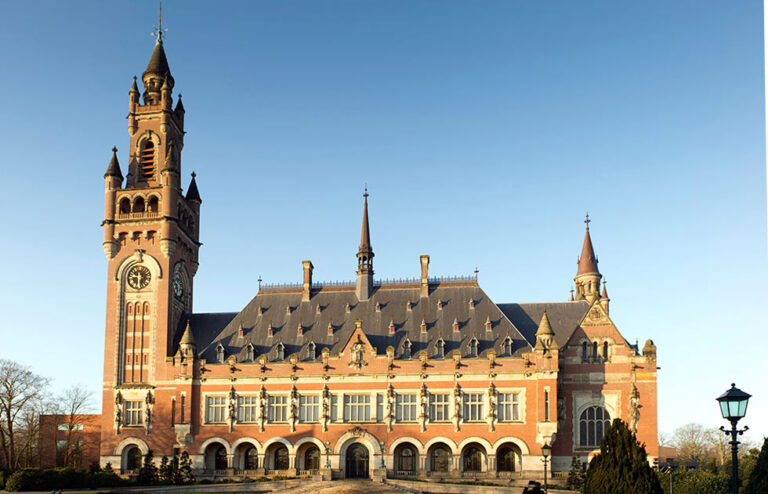
Over 130 drains flowing into River Ganga closed in the last 6 years
New Delhi: Prime Minister Narendra Modi inaugurated India’s first of its kind Ganga Avalokan Museum in Haridwar, and also country’s first 4 storied 7.5 MLD Sewage Treatment Plant in Muni ki Reti town in Chandreshwar Nagar in Uttarakhand through video conference today. While the Museum in Haridwar showcases the culture, biodiversity and rejuvenation activities done in Ganga river, the STP in Chandreshwar Nagar occupies less than 900 SQM area which is about 30% of the usual area requirement for STPs of such capacity.
While Modi said the Ganga Avalokan Museum would be a special attraction to pilgrims and it would further enhance the understanding of the heritage associated with Ganga, about the four storeyed STP, he said the Chandreshwar Nagar drain had turned as an eyesore to visitors and rafters at Muni Ki Reti, in Rishikesh. He applauded the closing of the drain and the construction of the four storied STP at Muni Ki Reti.
The Prime Minister listed the efforts taken to close more than 130 drains in Uttarakhand from flowing into the River Ganga. He said under Namami Gange Mission, projects worth more than Rs 30,000 Crores were either in progress or had been completed. He pointed out that due to these projects the sewage treatment capacity of Uttarakhand had increased 4 times in the last 6 years.
In all 30 projects are now complete in Uttarakhand for taking care of pollution from 17 Ganga towns near river Ganga.
Modi today also inaugurated projects under Namami Gange Mission, that included two Sewage Treatment Plants of 18 MLD capacity at Sarai in Haridwar and of 68 MLD capacity (which also marks completion of the first sewerage project taken up on hybrid annuity mode of PPP) at Jagjeetpur where another upgraded 27 MLD STP was also inaugurated. These STPs are in the Haridwar-Rishikesh zone, which contributes about 80 per cent waste-water load into the River Ganga. Besides he inaugurated four more STPs – a 26 MLD STP at Lakkadghat in Rishikesh, a 5 MLD STP at Chorpani, and two STPs with capacities of 1 MLD and 0.01 MLD at Badrinath.
The Prime Minister said there were lack of clear guidelines and coordination on an important subject like water because of the fragmentation of work into various ministries and departments. “As a result, problems related to irrigation and drinking water continued to persist,” he said adding that this was the reason why the Ministry of Jal Shakti was formed to bring in a synergy and give impetus to dealing with these challenges. He said the ministry is now engaged in the mission of ensuring access to piped drinking water to every house in the country.
Shri Modi highlighted the importance of keeping the River Ganga clean as it plays a significant role in sustaining the lives of about 50 percent of the country’s population from its origin in Uttarakhand till West Bengal.
He termed the Namami Gange Mission as the largest integrated river conservation mission which not only aims at the cleanliness of River Ganga but also focuses on comprehensive upkeep of the River.
Stressing on the need of public participation and foresight to make the River Ganga return to life, he said his government moved forward with a four pronged strategy to achieve its objective —
- Started laying a network of Sewage Treatment Plants (STPs) to prevent the waste water from flowing into the Ganges
- The STPs were built by keeping in mind the demands for the next 10 – 15 years.
- By making around hundred big towns/cities and five thousand villages along the River Ganga Open Defecation Free (ODF).
- By making an all-out effort to stop the pollution in the tributaries of River Ganga.
Modi also released the new logo for the Jal Jeevan Mission, and a book “Rowing Down the Ganges” co-published by National Mission for Clean Ganga & Wildlife Institute of India. This colourful book is an attempt to merge the biodiversity and culture of the Ganga River. It conceptualizes the story of the Ganga as what one would see when one rows down from Gaumukh, its origin, to Ganga Sagar, the last point before entering the sea.
More over the Prime Minister also unveiled the ‘Margdarshika for Gram Panchayats and Paani Samitis under Jal Jeevan Mission’ (Guidelines for the Village Panchayats and Water Committees). Referring to the Margadarshika, the Prime Minister said that they were equally important for the Gram Panchayats, people living in rural areas as well as for the Government machinery.
Moreover, Modi also announced a special 100-day campaign from October 2nd to ensure drinking water connection to every school and Anganwadi in the country
– globalbihari bureau





